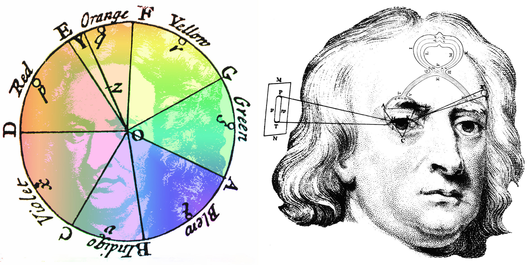Isaac Newton1642–1727
Newton contributed to mathematics, natural philosophy and neuroscience, although the last is not so well known. Newton’s Opticks, published in 1704, was concerned principally with light and colour, but it also made a remarkable, and understated, contribution to visual neuroscience. Colour compounds the physical and psychological dimensions of optics, although an appreciation of this was only possible when the physical properties of light had been elucidated. In his Opticks Newton illustrated and interpreted the spectrum produced by sunlight passing through a prism: differences in colour were related to differences in the amount they were refracted by the prism. His diagram of light passing through a prism and forming an elongated spectrum is shown in the portrait on the right. He also noted that colour was a subjective experience rather than a property of light: “For the Rays to speak properly are not coloured. In them there is nothing else than a certain power and disposition to stir up a sensation of this or that Colour”. That power was dependent in part on the degree to which sunlight was refracted when passing through a prism. A wide range of colour phenomena was available to Newton before he conducted his prismatic experiments, including the prismatic colours themselves. The phenomena concerned colour mixing, afterimages, colour contrasts and colour shadows; they had accumulated over centuries and spawned competing theories. Most theories were based on the Aristotelian view that colour was a property of bodies, and that it was carried by light through the transparent medium to the eye. Newton provided a unified theory of light and colours: white light was not unitary but compounded, in precise proportions, of many components that differed in their refraction. He was able to analyse the prismatic colours with an armoury of subtle experimental procedures. For example, small sections of the prismatic spectrum could be isolated and mixed with other parts, so that the rules of their mixture could be determined. On the left, he is shown within the colour circle he drew (although his illustration was in black and white). In Query XV of Opticks he asked whether the fibres from corresponding regions of each eye were united before they reached the brain, adding a telling reflection on species differences in the visual pathways to the brain: “Are not the Species of Objects seen with both Eyes united where the optick Nerves meet before they come into the Brain, the Fibres on the right side of both Nerves uniting there, and after union going thence into the Brain in the Nerve which is on the right side of the Head, and the Fibres on the left side of both Nerves uniting in the same place, and after union going into the Brain in the Nerve which is on the left side of the Head, and these two Nerves meeting in the Brain in such a manner that their Fibres make but one entire Species or Picture, half of which on the right side of the Sensorium comes from the right side of both Eyes through the right side of both optick Nerves to the place where the Nerves meet, and from thence on the right side of the Head into the Brain, and the other half on the left side of the Sensorium comes in like manner from the left side of both Eyes. For the optick Nerves of such Animals as look the same way with both Eyes (as of Men, Dogs, Sheep, Oxen, &c.) meet before they come into the Brain, but the optick Nerves of such Animals as do not look the same way with both Eyes (as of Fishes and of the Chameleon) do not meet, if I am rightly informed.” The query only hints at the insights Newton derived from his experimental enquiries. He had carried out experiments on optic nerves around 1682 but he did not publish details of them. He conducted experiments on optic nerves which resulted in the first representation of partial decussation at the optic chiasm and he proposed a theory of binocular single vision based upon it. The pathways from the eyes to the brain, based on Newton’s rough drawings, are also shown in the illustration on the right.
